Barcelona welcomed Real Sociedad to the Camp Nou for another thrilling La Liga contest. Even though they weren’t in great form, Ronald Koeman’s troops snatched away all three points from Imanol Alguacil in the Catalan capital.
Still, it was a true game of two halves, which will also be addressed in the full analysis. That being said, this tactical analysis will focus on both teams’ tactics and how they sought to outplay one another.
Lineups
Barcelona are a team ridden with injuries and as such, Koeman is forced to experiment week in week out. Marc-André ter Stegen, however, is a steady presence between the sticks but ahead of him, he found two youngsters, Ronald Araújo and Óscar Mingueza since the coach decided to drop Clément Lenglet.
Jordi Alba and Sergiño Dest were the full-backs while Sergio Busquets, Frenkie de Jong and Pedri were positioned in midfield. Up top, Martin Braithwaite started on the left, Lionel Messi down the middle and Antoine Griezmann was the right inside forward.
Barcelona were deployed in a 4-2-3-1 formation on paper but that seemed more like the traditional 4-3-3 on the pitch with Pedri and De Jong as interiors.
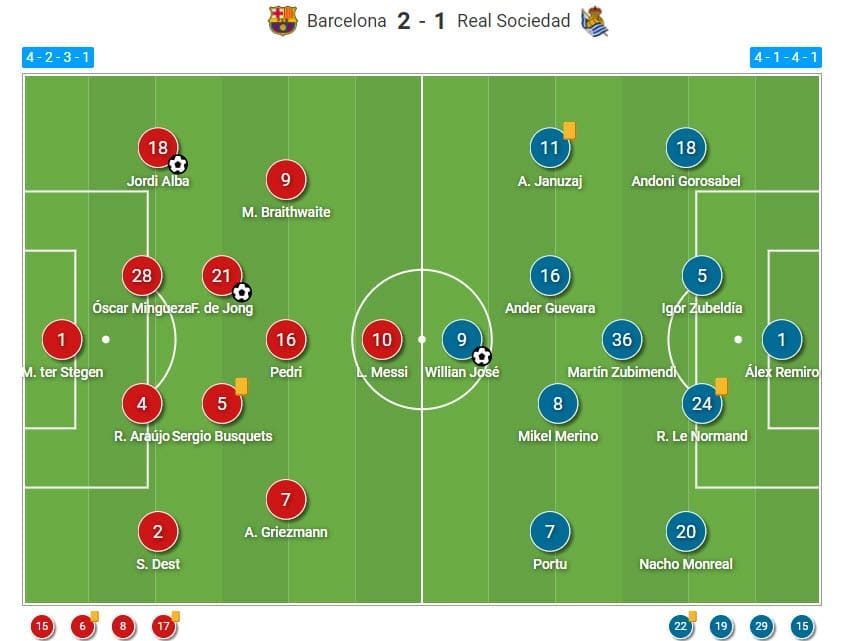
Real Sociedad also had a couple of big absences, mainly in the form of David Silva and Mikel Oyarzabal, two of their most important players within the squad. Other than that, Alguacil opted for a strong side with Álex Remiro manning the sticks and a quartet of Nacho Monreal, Robin Le Normand, Igor Zubeldia and Andoni Gorosabel in the backline.
In midfield, La Real had Martin Zubimendi as the lone pivot, supported by Mikel Merino and Ander Guevara as the interiors. Finally, in the forward line, we saw Portu on the left, Willian José down the middle and Adnan Januzaj on the right.
Real Sociedad were deployed in a 4-1-4-1 structure but similarly to their opposition, this would often transform throughout the game.
Barcelona’s improved attacking tactics & Pedri
The major change in Barcelona’s overall approach and tactics lies in the return to their traditional 4-3-3. While the numbers on the paper don’t matter as much, player roles and responsibilities do. Below you can see the Catalans’ standard build-up structure against Real Sociedad’s settled defensive system.
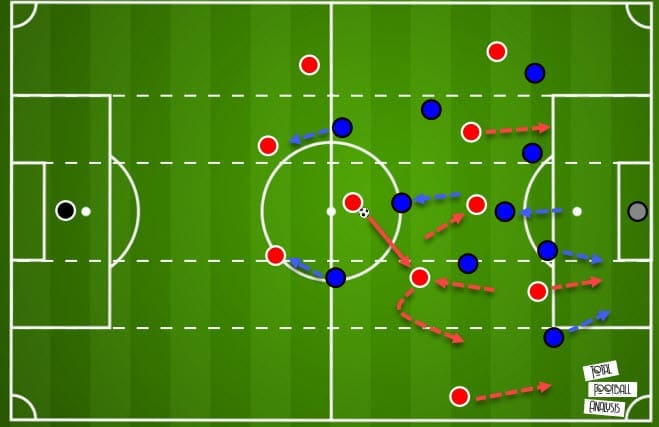
With two interiors back in the squad in the form of De Jong and Pedri, Barcelona were able to receive possession in pockets of space between the lines and occupy the main vertical channels in attack. The key was to find one of the two ‘8s’ or ideally Messi in those areas from where they can orchestrate the play.
The Argentine would drop deeper regularly to receive a pass from either the backline or the sole pivot from the deep. This was probably the most important aspect of their attacking tactics on the night, as can be seen from the graph above. Once Messi is on the ball, he can turn and influence play higher up the pitch.
As soon as he drops, however, that triggers the interiors’ movement to take his place in the final third. Real Sociedad swapped through various defensive systems from a more settled 5-3-2 to the more aggressive 3-5-2 or 4-5-1 when pressing higher up the pitch. It has to be noted, however, that they were extremely aggressive throughout the whole game so a situation like the one below was far more common from Barcelona’s point of view.
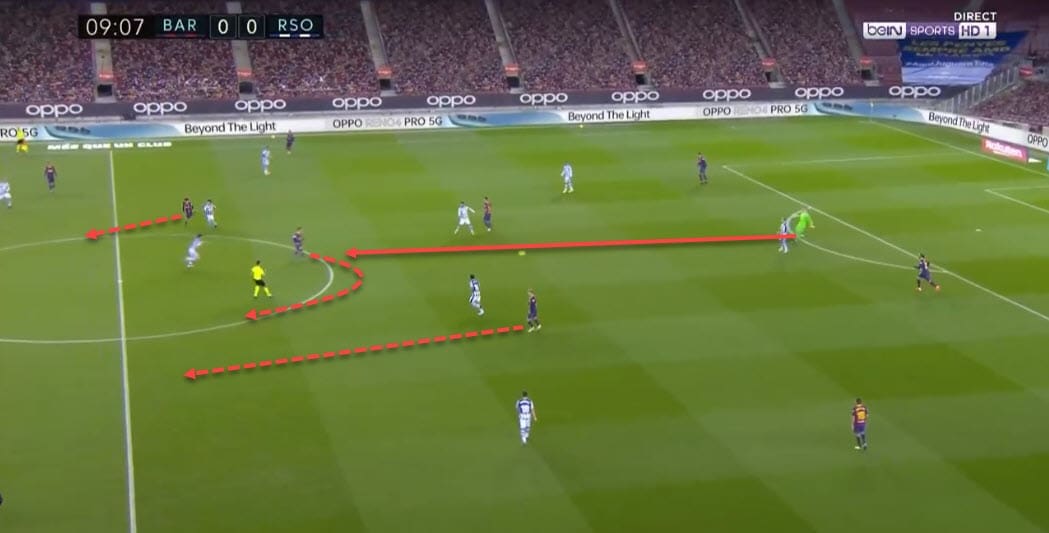
La Real would assume a heavy man-marking structure when advancing deep into Barcelona’s half but they didn’t have much success. There are two main reasons behind that. Firstly, the Catalans would use the goalkeeper as an outfield player, creating a numerical superiority in the first line and secondly, Messi would drop to create another overload in the middle third of the pitch.
As was already mentioned earlier in this tactical analysis, him dropping was an instant trigger for both Pedri and De Jong taking up a much more advanced position. This can also be seen in the image above.
Once he receives the ball, Messi would usually be instantly pressured from behind with his back to goal but with the low centre of gravity and incredible dribbling ability, often he was able to lose the marker and deploy passes up front. Without a doubt, this was Barcelona’s best mechanism to escape Real Sociedad’s aggressive pressing tactics.
So how did they achieve it? Apart from the aforementioned way of Messi dropping deeper and receiving from the pivot, which would require him to beat his marker for Barcelona to advance, there were other tactics as well. One was De Jong’s flexibility to either push high or become the third centre-back on the left.
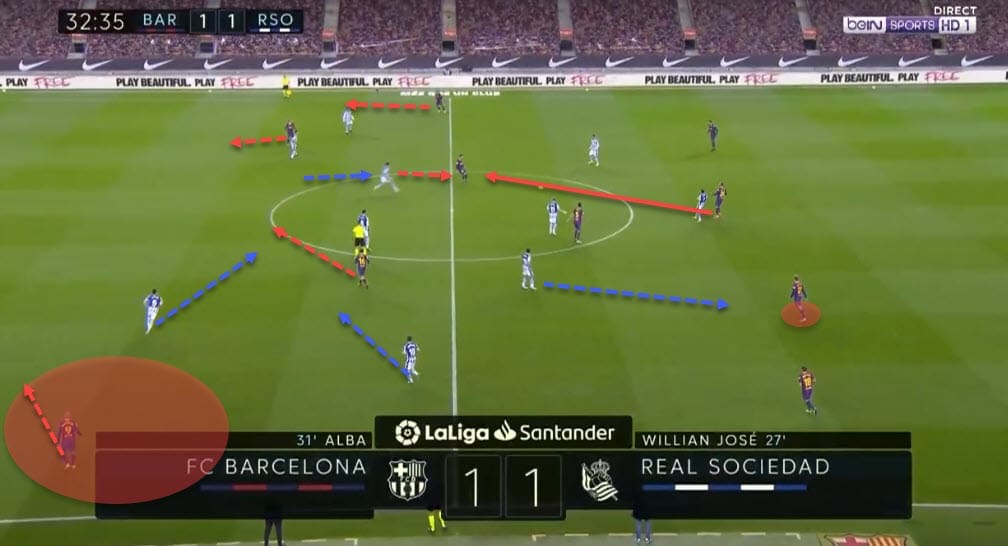
As you can see, this immediately forces a reaction from Real Sociedad. The interior on the right side is attracted to De Jong’s movement even though he doesn’t advance up to press aggressively. This enables Pedri to move behind into a pocket of space, which in turn engages both Zubeldia and Gorosabel, leaving Braithwaite alone.
Once Messi drops, one of two things will happen. Either he gets followed by a defender, creating a gap behind or the defender stays put, leaving Messi to receive in space. Either way, Barcelona win by manipulating the opposition’s movement from the second and the first line.
The other important aspect here is the process of pinning down the defenders.
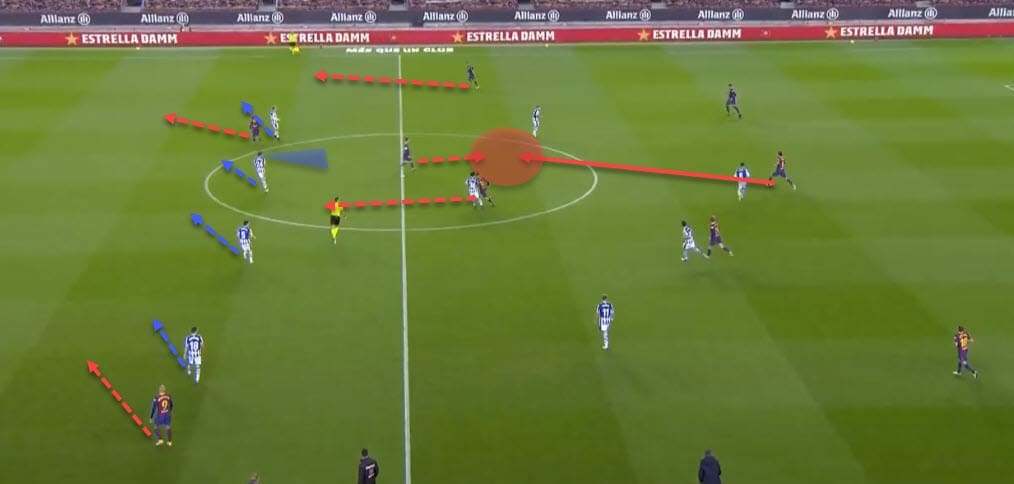
This task fell on the shoulders of Griezmann and Braithwaite, whose roles were more functional on the night. Their job was to keep Real Sociedad from engaging Messi, De Jong or Pedri who would be extremely active between the lines. Above you can see a successful instance of pinning where Messi can then receive the ball unmarked.
But apart from the Argentine, Pedri was the other shining light for Barcelona. By giving him the freedom of a number eight, Koeman unleashed his full potential. The youngster was one of the reasons why Barcelona’s ball circulation was rapid and they managed to combine in tight spaces to outplay Real Sociedad’s defensive block.
Due to his excellent technical ability and press resistance, Pedri was used both as a valve to relieve pressure, similarly to Messi’s role, and as a key component in quick final third combinations.
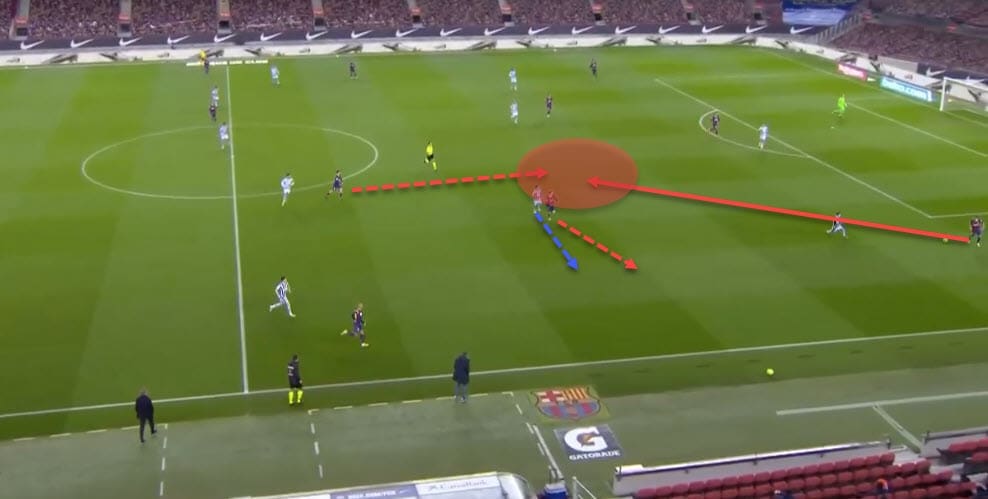
Above, you can see the 18-year-old mimic Messi’s movement to drop deep and receive in the face of a high press. De Jong’s movement is also important here as he drags away the marker, creating a channel for the backline to exploit and access Pedri.
Once on the ball, he would wiggle his way out of Barcelona’s half and advance the attack. But as was mentioned earlier in this tactical analysis, he was also important once the play was successfully transferred in front of La Real’s box.
There, Pedri would usually receive between the lines and engage in quick interplays to bypass the block and get into the penalty area. This was usually done via the third-man principle or a simple lay off towards Barcelona’s key targets.
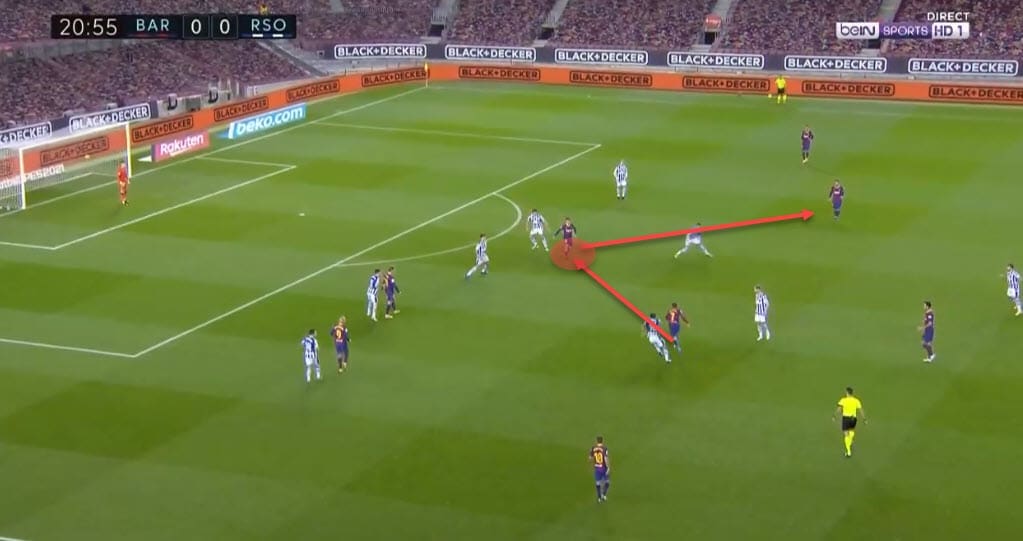
The Catalans were dominant throughout the first half and at the beginning of the second but afterwards, once their intensity dropped, it was time for Real Sociedad to turn up the heat.
How Real Sociedad grew into the game
If the first 45 minutes or so were all about Barcelona then the second were all about Real Sociedad. Of course, La Real were the ones to strike first but couldn’t keep the Catalans away, allowing them to overturn the game and win from a deficit for the first time this season. In the first half, the guests were quite timid in possession but had clear mechanisms to advance the play.
Below, you can see a graphical representation of their build-up sequences that include different options for the ball-carrier.
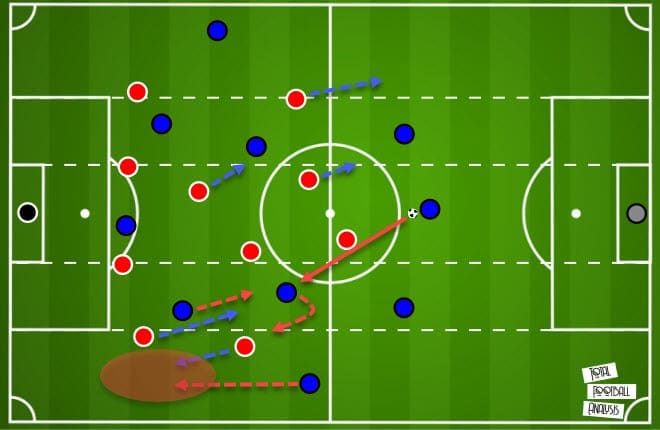
In the attacking phase, La Real would drop Zubimendi between the centre-backs and keep Merino and Guevara close by in their half-spaces. The key here was to either find Januzaj or Porto between the lines or to somehow isolate their full-backs in a 1v1 duel against Barcelona’s defenders.
The Catalans, on the other hand, swapped between a high and a mid defensive block, moving from a 4-1-4-1 into a 4-4-2 and then into a high press depending on the situation. Initially, De Jong or Busquets would stay just ahead of the backline and keep track of Real Sociedad’s roaming forwards while Messi was the lone forward in the first line.
Once they started to push up, Pedri and Braithwaite would join the Argentine as Barcelona tried to divert Real Sociedad towards the edge of the pitch. Let’s first take a look at those defensive tactics down in the example below.
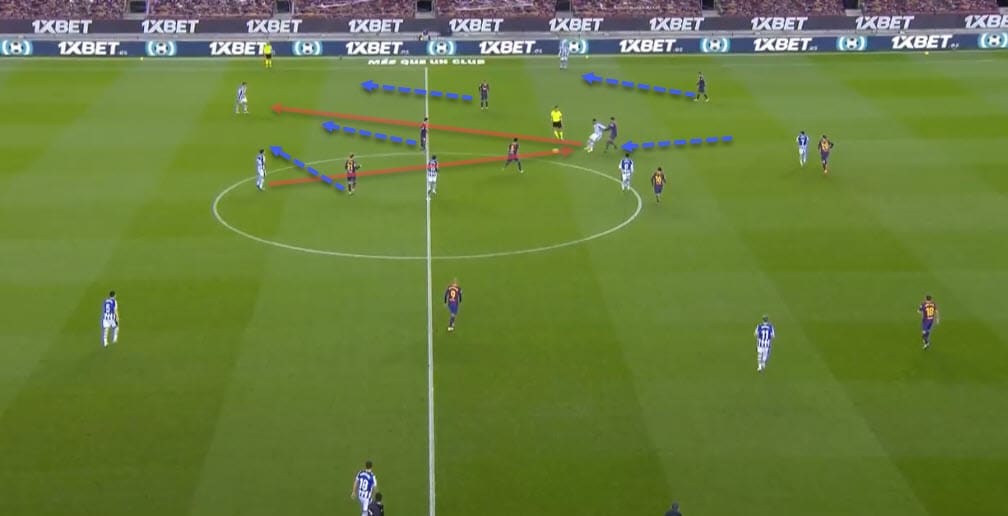
In this sequence, we see Real Sociedad in their general build-up structure – pivot between the centre-backs and half-space occupation higher up the pitch. But as soon as José drops deeper to receive, he is pressurised from the back, prompting the striker to lay the ball off to the left side of the pitch.
Notice how the whole Barcelona structure moves up as soon as that happens, collapsing near the touchline and forcing a bad pass from the team in possession. The Catalans often push their defensive line higher but are not among the most aggressive pressers in La Liga, on the contrary, they rarely engage in a high press but will mirror the opposition in a high block, dialling things up in the middle third instead.
Let’s now tackle Real Sociedad’s tactics to bypass Barcelona’s high and mid blocks. The first mechanism was to stretch the Catalans’ structure to find pockets in which players like Januzaj or Merino could receive the ball and then drive with it forward.
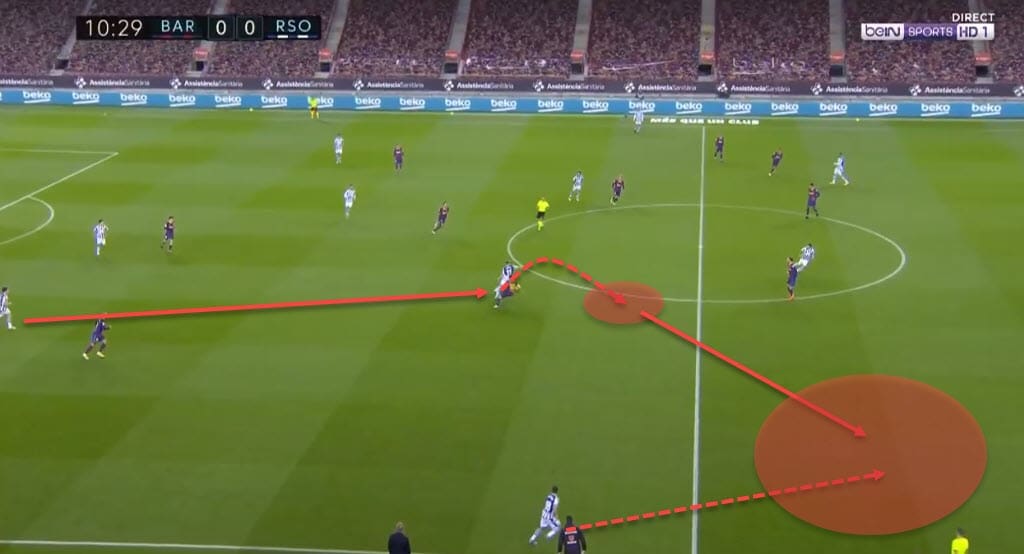
In the example above, the backline finds a channel that leads directly into one of the key targets and upon receiving the pass, Januzaj quickly turns and can then deploy a piercing ball into space for Gorosabel.
This type of movement was very common for the away side, only the details would change depending on the situation. If Januzaj, Porto or even José wouldn’t be able to directly receive the ball in advantageous positions, the goal would be to isolate the full-backs.
You can see a very similar example down below once again, only this time the receiver is Monreal as opposed to Portu or José who would usually operate in that area.
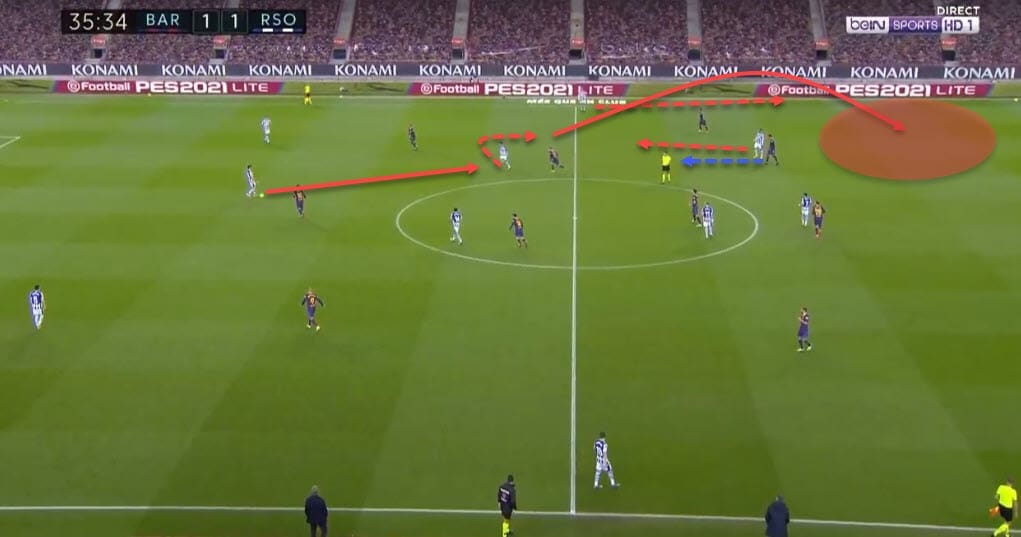
The striker drops deep, manipulating the heavy man-marking scheme of Barcelona’s centre-back, while Zubimendi finds Merino in that pocket we mentioned earlier in the tactical analysis. The interior can then turn the ball and De Jong with it, deploying a pass over the top and put his full-back into an isolated 1v1 duel with his counterpart.
And while Barcelona still had a chance to win the individual duels out wide, they would mostly favour the attacker due to their deeper starting positioning and dynamic superiority, meaning they would achieve higher velocity sooner with timing on their side, catching the defenders off guard.
But despite scoring a goal in the first half and initially taking command of the lead, it wasn’t until the second 45 minutes that Real Sociedad truly started to tick. Barcelona’s intensity died down and it became much easier for the guests to control possession and thus, the game.
Alguacil also made some changes, bringing in the likes of Alexander Isak and Robert Navarro, who both changed the game to a certain extent. The former would work in unison with José and as one dropped deep, the other would run in behind the defensive line, awaiting a direct through ball into space.
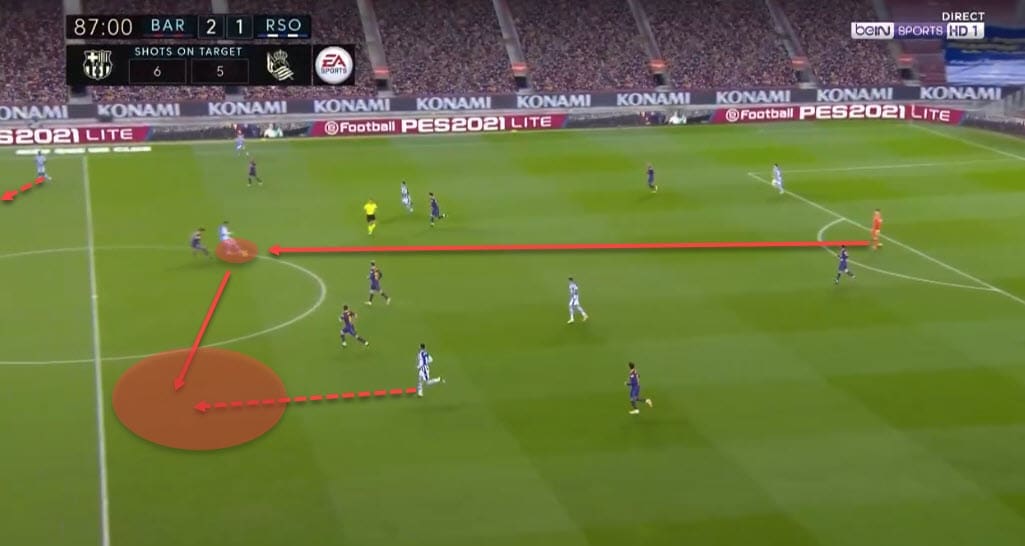
The role of the latter was to work between the lines, much like Pedri and De Jong did for Barcelona and suddenly, Real Sociedad’s ball circulation and space occupation were on a much higher level.
Interestingly, they also managed to bypass Barcelona’s high block much easier as Koeman’s changes seemed to weaken the team in that regard. Often, we could see La Real putting the Catalans into a decisional crisis, successfully utilising the overloads in certain areas to gain numerical superiority.
One such example can be seen below as the third man principle is used extremely well to find the player in the half-space.
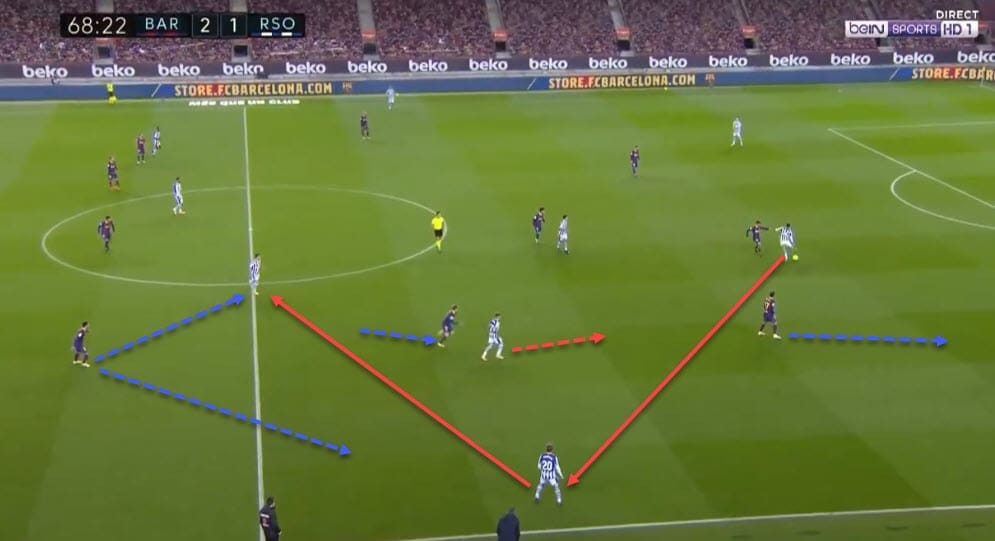
As a result of their movement manipulation and swift interplay, Real Sociedad have successfully put Barcelona’s backline into an unenvying situation where one player has two attackers to mark.
These types of situations, as well as more penetrative and incisive passing, led to a couple of incredible chances but the visitors could not capitalise on them in the end.
Final remarks
2-1 does feel like a fair result at the end of the day. Both teams had their time under the sun and both had chances to score more than they have by the referee’s final whistle. However, with such a dominating display for just over one half of the game, it does feel like Barcelona deservingly took away all three points.
Real Sociedad are still only behind Atletico Madrid in the standings but this defeat will surely hurt them. Can they return to winning ways and then keep up the good results?
Only time will tell.






Comments